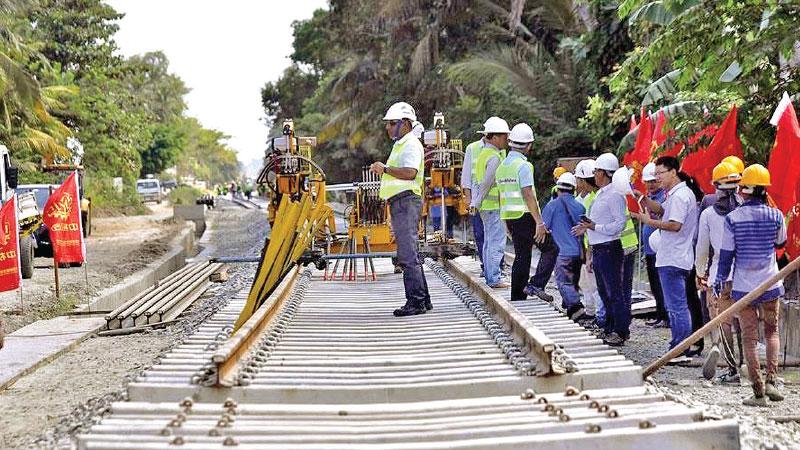
The Southern railway extension from Matara to Hambantota, that is being built, is a dream come true to this writer as well as for thousands who live down there. This extension was scheduled to be completed up to Beliatta in December and its extension thereafter to Hambantota where the new port operates. The potential development outcome of these two projects, the railway and the new port together with the Mattala airport would be of immense value in terms of industry and trade development in the immediate region and its hinterland.
The expected growth in industry and trade, linking global markets via the new port in Hambantota and the Mattala airport complex is bound to change the pace and pattern of development in Sri Lanka. The region expected to benefit from this mega project had been neglected and marginalised for well over a century, depriving the people the opportunities and socio economic progress, despite their willingness for hard work and dedication. It is a fact that Southerners, had to wait so long, perhaps in despair for good things in life, and what is called progress in life and work.
This writer recalls with nostalgia a train trip with younger brother (Daya) and a friend (Samarasekara of Kirama), from Matara to Kamburugamuwa, to get the feel of the southern railway journey, on the very day of independence in 1948, as teenage schoolboys. Returning from Kamburugamuwa, I remember how we felt ending the trip at the Matara railway station, unable to proceed beyond by train to reach Dikwella, where we were boarded as schoolboys. It is sad for the southerners, who had to wait - 70 years - after independence, and of course 100 years after the railways was first introduced to the country, for this railway extension beyond Matara.
British
The British colonial government built railways in Ceylon then, except for the northern line, primarily to serve their tea and rubber plantation industries rather than for the country’s socio economic development, which came in only as a fringe benefit.
Not extending the railway beyond Matara by the British may have been due to two reasons, there were no British owned plantations in the Deep South and there was the history of the Wellassa Rebellion to reckon with.
In policy making in the post independent period the local political leaders mostly being Colombo based were more interested in developing the hinterland of Colombo for trade and industry, rather than remote regions such as, the Hambantota or the Moneragala districts.
Hence, this region remained relatively neglected for nearly a century, resulting in unemployment, poverty and other ills of economic deprivations and progress. Whatever development in the past was grossly inadequate to improve people’s living standards or match the potential of the region for development.
The more enterprising persons migrated from their native villages, to the port city Colombo and other towns, thereby creating a void in the southern region of entrepreneurial talents and native skills.
Hence, what was lost in talent migration out of the deep south in Sri Lanka, the Colombo district gained. Had the railway line been extended beyond Matara and the port developed in Hambantota in time, perhaps our country’s developments would have been more rapid and more balanced than what we see now. This is because Hambantota lies close to one of the biggest trade routes in the world, the east/ west main trade flow in the Indian Ocean.
Southern railway extension
Initially, the southern railway extension would attract passenger traffic, particularly, the pilgrims to Kataragama and the tourists to beach hotels in the South. Gradually, the expected trade and industry growth in and around rail road stations, beyond Matara up to Hambantota, would bring about a shift of population and settlement pattern in the region. The prospective growth relating to the new port in Hambantota, for large scale industries and logistical services that would spin off can push the whole region to a new growth trajectory. There is enough evidence to show positives in this direction.
The presence of entrepreneurship and business skills are there in the people living there, the steady growth of urban centres like Embilipitiya, from a sleepy township, testifies these prospects. For generations our migration from the south due to the neglect of these areas has benefitted Colombo and other areas.
This imbalanced structure should change for sound economic reasons such as, rising costs of land and space, overcrowding settlements, traffic congestion and sheer waste of energy involved, with high import costs, most of this being related to the issue of saturation of Colombo based potential.
The extension of the railway beyond Matara to connect with the new harbour in Hambantota can change this and enable the country to enter a new vista of development and growth. However, one caveat this writer would like to pinpoint is that related to environment management.
Proper conservation backed environment for this region is urged, mostly because of long periods of undisturbed ecology and natural build up, of nature showing sometimes a superb blending of charm and beauty of immense value. This certainly has prospective long term values to the nation.
